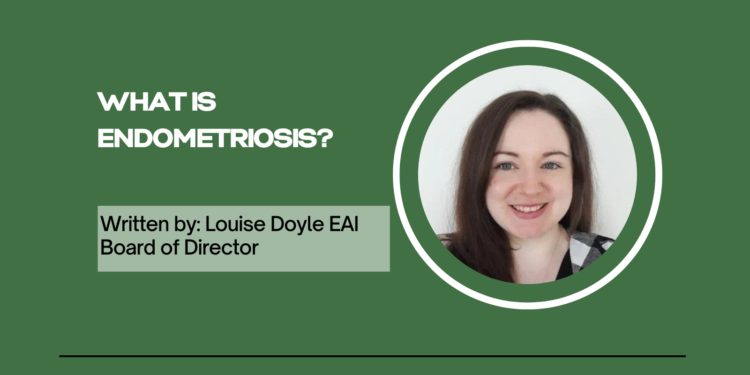Written by Louise Doyle, EAI Board Director/Trustee, Endometriosis Association of Ireland
Endometriosis is a chronic inflammatory condition that is estimated to affect 1 in 10 of those assigned female at birth. Endometriosis is where tissue similar to the lining of the womb is present outside of the womb. It has been found on every organ of the body.
The condition causes an inflammatory reaction which may also lead to the development of scar tissue and lesions within the body. There are several types of lesions that are known and vary in severity which are related to the stage of the condition.
The endometriosis deposits are known to react similarly to normal endometrium during a hormonal cycle, which can cause symptoms to become worse during various times throughout the cycle, especially during ovulation and menstruation.
The level of pain and discomfort a person experiences from endometriosis does not directly correlate to the severity of the disease.
What are the symptoms?
The symptoms of endometriosis can begin prior to the first menstrual cycle and be persistent for the remainder of a person’s life, which can have a negative impact on quality of life.
This disease can be characterised by multiple symptoms including painful periods, menstruation pain, pelvic pain, discomfort during and after sex, fatigue, bloating, nausea, infertility and more. This is not an exhaustive list of symptoms, with the condition having an individual impact on each sufferer with varying ailments, not all of which are physical, and this can make it hard to diagnose and treat.
How is endometriosis classified?
The American Society of Reproductive Medicine (ASRM) developed a staging system for endometriosis. This classification system is used by gynaecologists to determine the level of visible endometriosis and adhesions during surgery. A higher stage is usually associated with a more severe form of the condition but does not directly relate to the pain or discomfort felt by the sufferer or to the complexity of surgery.
Stages 1 and 2: minimal to mild disease – superficial endometriosis which is found primarily in the pelvis
Stages 3 and 4: moderate to severe disease – deep penetrating endometriosis can be found on the bladder, bowel and on other organs outside of the pelvis
Cystic ovarian endometriosis also known as “chocolate cysts”, is a cyst that is filled with old blood where endometriosis is also present on the wall of the cyst. These can be found in patients with varying grades of the disease.
How is endometriosis treated?
There is no known cure for endometriosis and treatment is based around managing symptoms and the best treatment options are also dependent on a person’s individual situation. Hormonal medication, usually in the form of contraceptives, is one of the first forms of treatments prescribed to a person impacted by the condition to try and help lessen the severity of symptoms. Hormone therapy can include:
The pill
IUDs
Implants
Injections
Patches
Vaginal rings
Analgesics like paracetamol and non-steroidal anti-inflammatory drugs (NSAIDs) can help reduce pain felt by sufferers. NSAIDs are a preferred type of pain relief due to inflammation caused by endometriosis. In some cases, standard pain killers may not be proficient in helping to relieve symptoms and co-codamol/ co-dydramol or opioids may be prescribed.
In more severe cases surgery is required for the treatment of endometriosis. Surgical interventions look to remove endometriosis lesions, divide adhesions, and restore nerve pathways. Excision and ablation surgery are the techniques used to treat endometriosis. Excision, which is considered the gold standard, is the physical removal of the lesions and surrounding tissue while ablation vaporises and destroys the tissue.
Ovarian endometrioma is often needed to be treated with surgery. There are varying surgeries available including a cystectomy, the cyst is cut out, ablation, the lining of the cyst is removed and electrosurgery, where an electric current is used. The surgery requires a balance to both remove the ovarian endometrioma successfully, but also to preserve the ovarian reserve.
It is a common misconception that a hysterectomy can “cure” endometriosis. This is not true as the lesions do not come from the uterus. If endometriosis is left untreated and not removed at the time of a hysterectomy,
symptoms can continue to be present post surgery. Those on HRT (including those without a womb or using an IUD) can benefit greatly from adding body identical progesterone to their regime. A holistic approach is needed for the treatment of symptoms and should include complementary and alternative therapies to assist with pain management. Together, traditional medical and surgical treatment with complimentary therapies, can have a positive impact. Some therapies that can help are:
Pelvic physiotherapy
Nutrition
Herbal medicine
Acupuncture
These treatment options have been shown to help decrease muscle tension, develop better muscle tone, improve relaxation, help prevent depressive symptoms and improve overall sense of wellbeing.
Endometriosis can be a debilitating condition. Much more rigorous research is needed to understand the disease better and to learn how to treat the condition more effectively.
For more information visit www.endometriosis.ie










